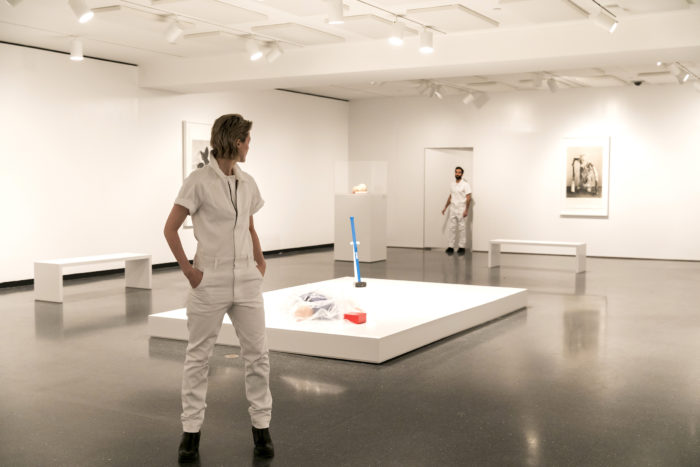
You can be forgiven for momentarily thinking that you’ve stumbled upon a random New York rant. But David Levine’s performative installation at the Brooklyn Museum, Some of the People, All of the Time, doesn’t hide the fact that it’s as much straight-up drama, the kind you might see in an off- Broadway theater, as the kind of lecture performance pioneered by artists such as Andrea Fraser, Fred Wilson and Walid Raad.
It doesn’t take long for it to pull you in. Eight professional actors take turns performing the 55-minute monologue throughout the day, roving the gallery in stylish white jumpsuits and breathing life into the confessions of an unlikely antihero: the fake crowd actor—the kind, we are reminded, that Donald Trump hired to serve as his audience when he announced his candidacy for the presidential nomination in 2015.
Levine, a 47-year-old native New Yorker, thus unfolds what is at once a grand allegory and a history lesson about our social media present, in which facts matter less and the crowd—its size, wisdom and data—matters more. Further, his dramatis personae aren’t content to just tell you their story. In a gallery with no boundaries between audience and actor, one grows self- conscious quickly and the whole affair takes an uneasy twist. Should I sit or stand? Can I go to look at the photograph on the far wall and listen to the actor at the same time? Why is the guy in the back laughing so hard? Is he a real museum visitor? Why does the woman in the gray suit keep playing with her hair like that?

Performance art is nothing new, of course, but Levine is perhaps unique in that he brings full-blown realist drama and bonafide acting into the gallery and the museum. “The one thing that’s absolutely taboo in contemporary art is fully committed, non-Brechtian, realist performance,” Levine observes. He credits a production he saw in Berlin in 2004 at the Volksbühne—the “People’s Theater” where many of the last century’s most experimental productions were first staged—with showing him the possibilities at the intersection of theater and art. “The piece was just three actresses sitting around grousing about late capitalism and their day jobs. They didn’t seem to draw distinctions between what is and what isn’t acting.” Everyday artifice and the illusion called forth by the actor, Levine believes, are inseparable, material and social conditions every bit as important as, say, the surface of a painting, the space of the gallery or the gendered body.
Ultimately, Some of the People is as much about us as it is about the reality television that has become the American national melodrama. After all, everyday life has always been our biggest role.



